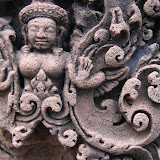 |
| Temples outside of Siem Reap |
We settled into the Red Lodge, a very nice (and cheap) guesthouse in Siem Reap. The next day, we set out with two friends from the US (who were in Asia for a conference) to visit some of the temples surrounding the city. We hired a car and driver for the day, since the temples we sought were hours outside of the main city, beyond the reach of bicycles. Our first stop in the morning was Bantea Srei, notable for the pinkish stone that was used in its construction. The site consisted of a large perimeter wall, and intricately carved interior structures. The hue of the stone was beautiful, and made for great photos (if you could manage not to get all the other tourists taking pictures in your shot).
After a brief break from the heat drinking fresh coconut juice in the shade, we drove off to our next destination, Kbal Spean. Unbeknown to us, getting to this site would not be as easy as simply strolling in from the parking lot. We needed to do quite a bit of hiking through the jungle to get there, but the walk was very pleasant as we brushed through the lush emerald foliage and wandered deeper into the unknown. The remoteness of the ruins also contributed to its preservation, as there were much fewer tourists to contend with and you could more easily imagine yourself as an explorer coming upon a sacred site for the very first time. The signature features of Kbal Spean are it's underwater carvings. Most of the notable depictions are found within waterfalls and under shallow streams. The well preserved, though slightly obscured, carvings were directly in the bedrock which added some intrigue as to the logistics of carving rocks underwater (though they were probably created during a dry period).
From here, we sought out our final destination, Beng Melea. As a result of some closed roads, the drive took considerably longer than expected, and involved shuddering down dirt roads and fording a river in our driver's late-80s Toyota Camry. After wandering through very remote countryside and a few scattered villages, we finally made it (though slightly behind schedule) to the site of the ruins. Beng Melea was arguably the most spectacular of the three sites visited that day, and it provided an awe-inspiring scene of the battle between nature and human construction. The entire massive temple was ensnared in trees and vines that had crept in from the surrounding jungle. Roots wrapped around intricately carved stones, and huge trees rose up from within the walls, forming a canopy of green above the sacred site. We explored quickly since night was falling, and we were specifically warned by a local that this is when the snakes come out. Given the surroundings, I wouldn't have been surprised to see Indiana Jones there, running away from the snakes along with us.




No comments:
Post a Comment